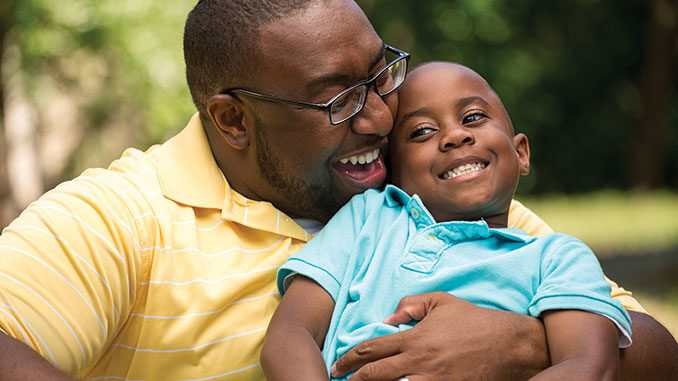
Laughing Out Loud is a simple solution to a happier life
Published: October 28, 2021
By: Sandi Schwartz
Sometimes life can be tough. Whether we are feeling anxious about current affairs or dealing with a health issue, something as simple as laughter — believe it or not — can help us persevere.
As adults, we tend to get bogged down with our to-do lists and stresses of daily life and forget how beautiful it is to let loose and have a good laugh. Unfortunately, most adults do not laugh enough. In fact, one study found that healthy children may laugh as much as 400 times per day, but adults only laugh 15 times per day.
If we stop for a moment and observe our children, they are probably laughing and playing freely without the weight of the world on their shoulders. We can learn so much from them when it comes to being lighthearted. It’s important that we raise them in such a way that they will continue to experience fun and laughter throughout their lives. We can create a positive environment for them to grow up in by pausing once in a while to have a laughing fit together.
Why Is Laughter So Important?
Science shows us that laughter really is like medicine. According to the Mayo Clinic, laughing is one of the easiest ways for us to reduce stress and anxiety in our lives. Laughing transforms our body and mind in so many amazing ways, boosting positive emotions like happiness, peace and humor. When we laugh, the ventromedial prefrontal cortex of our brain is activated. This releases feel-good hormones called endorphins that allow us to experience pleasure and satisfaction. Laughing also reduces our stress response because the level of stress hormones like cortisol, epinephrine (adrenaline) and dopamine are lowered. We feel energized since we take in more oxygen-rich air when we laugh. Finally, laughing relaxes our muscles, which soothes tension from stress. In fact, a good laugh can leave your muscles relaxed for up to 45 minutes afterward.
The muscles that help us smile also affect how we feel. When we use these muscles, we trigger a part in our brain that improves our mood. In one particular research study, participants were asked to hold a pencil in one of three ways to get them to make certain facial expressions without knowing why. The first group held the pencil sideways in their mouths to force a smile. The second group stuck the pencil in lengthwise to force a frown. The last group, serving as the control group, held the pencil in their hands. Participants were then asked to watch cartoons and rate how funny they were to them. The group with the sideways pencils (the “smiling” group) had higher funny ratings than the lengthwise group (the “frowning” group). The control group scored between the other two groups. This study showed how smiling and laughing can really make a difference in how we perceive the world around us.
Researchers also found that facial expressions can reduce negative feelings like pain and sadness. In one study, researchers applied an uncomfortable heat to subjects’ arms and then asked them to make either a relaxed face, an uncomfortable face, or a neutral face. The results showed that the people who made a relaxed face experienced less pain than those who made an uncomfortable or neutral face. This happens because smiling releases endorphins and serotonin, which are thought to minimize any pain we feel.
Laughter is beneficial because it also changes how we look at a situation. A silly moment can offer a healthy distraction from negative emotions like anger, guilt, and stress. It sure is hard to feel negative when you are cracking up. It also gives us a more lighthearted perspective when faced with challenges, and helps us view such events as positive opportunities as opposed to threats.
Laughter also builds resilience and the ability to adapt well to adversity, trauma, tragedy, threats, or even significant sources of stress. When children are resilient, they are braver, more curious, more adaptable, and more able to obtain happiness and success. Additionally, according to Mayo Clinic, resilience can help cushion us from mental health conditions like anxiety and depression because it improves our ability to cope. Laughter plays a huge role in how we handle adversity by allowing us to escape from our problems for a little while. By teaching our kids to laugh even in times of pain, we are giving them a key tool that will help them be more resilient as they grow older.
Laughing with our kids is so special because it builds a bond with them.
These joyous moments create a more uplifting environment at home. What’s really fun is that laughter tends to be contagious, so before you know it your whole house could be giggling up a storm. The best part of laughing is that it’s completely free and always accessible to us, without any side effects (except for maybe a few aches on your side from laughing so hard).
Laughing for Fun
So, how can we laugh more with our kids? Here are 9 ideas to get you rolling (on the floor)…
- Start a laughing contest to see who can make the other person laugh first.
- Play fun games like charades, Twister, Pictionary, and Hedbanz.
- Read joke books and websites, and then share your favorites with each other.
- Create funny stories using Mad Libs or whisper down the lane.
- Have a family talent show and see who comes up with the funniest routine.
- Dress up in silly costumes.
- Watch a comedy television show or movie together as a family.
- Talk in a silly language like pig Latin.
- Keep a collection of funny quotes and pictures that you can bring out at any time to get everyone laughing.
